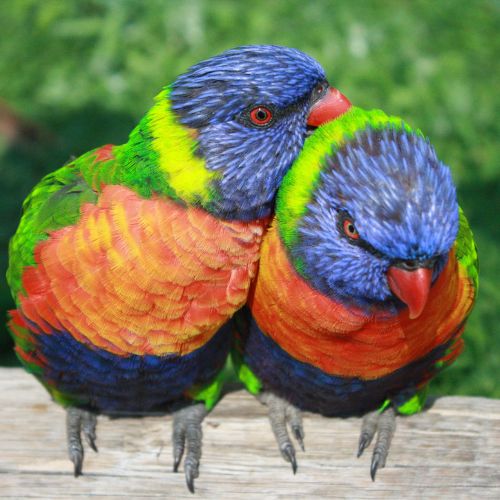Introduction
Lorikeets are vibrant, energetic parrots known for their striking colors and playful personalities. These small to medium-sized birds belong to the Loriinae subfamily and are native to Australia, Southeast Asia, and the Pacific Islands. Their unique brush-tipped tongues make them specialized nectar feeders, setting them apart from other parrot species.
In this guide, we’ll explore the features of lorikeets, different types of lorikeets, their care requirements, and the best foods for lorikeets to keep them healthy and happy.
Features of Lorikeets
Lorikeets are easily recognizable due to their bright plumage, energetic behavior, and specialized feeding habits. Here are some key characteristics:
1. Vibrant Colors
Lorikeets are among the most colorful parrots, displaying combinations of red, blue, green, yellow, and orange. Their dazzling feathers make them popular pets and aviary birds.
2. Brush-Tipped Tongues
Unlike other parrots, lorikeets have papillae (brush-like structures) on their tongues, allowing them to efficiently feed on nectar and pollen.
3. Playful and Social Nature
Lorikeets are highly active, intelligent, and social birds. They enjoy interacting with humans and other birds, making them entertaining companions.
4. Loud and Vocal
These birds are known for their chatter, screeches, and mimicry abilities, though they may not be as clear as larger parrots like African Greys or Amazons.
5. Size and Lifespan
- Size: 6 to 15 inches (depending on species)
- Lifespan: 15 to 20 years (with proper care)
Types of Lorikeets
There are over 50 species of lorikeets, each with unique colors and behaviors. Below are some of the most popular types:
1. Rainbow Lorikeet (Trichoglossus moluccanus)
- Appearance: Bright blue head, green wings, orange-red chest, and yellow collar.
- Habitat: Australia, Indonesia, and the Solomon Islands.
- Popularity: One of the most common pet lorikeets.
2. Scaly-Breasted Lorikeet (Trichoglossus chlorolepidotus)
- Appearance: Green body with yellow scalloped feathers on the chest.
- Habitat: Eastern Australia.
3. Red Lory (Eos bornea)
- Appearance: Deep red plumage with blue and black markings.
- Habitat: Indonesia.
4. Dusky Lory (Pseudeos fuscata)
- Appearance: Dark orange and brown with yellow streaks.
- Habitat: New Guinea.
5. Black-Winged Lorikeet (Eos cyanogenia)
- Appearance: Bright red with black wings and blue markings.
- Habitat: Indonesia (endangered species).
Lorikeet Care Guide
Proper care is essential to keep lorikeets healthy and happy. Here’s what you need to know:
1. Housing Requirements
- Cage Size: Minimum 24x24x36 inches (larger is better for flight).
- Bar Spacing: ½ to ¾ inches to prevent escape.
- Perches: Natural wood branches of varying thickness.
- Toys: Provide chewable toys, ropes, and puzzles to keep them mentally stimulated.
2. Temperature and Environment
- Ideal Temperature: 65°F to 85°F (avoid drafts).
- Humidity: Moderate (40-60%).
- Lighting: Natural sunlight or full-spectrum UV light for vitamin D synthesis.
3. Socialization and Handling
- Lorikeets thrive on daily interaction.
- They can be trained to perform tricks and mimic sounds.
- Avoid leaving them alone for long periods (can lead to stress and feather plucking).
4. Hygiene and Cleaning
- Clean food and water dishes daily.
- Replace cage liners every 2-3 days.
- Bathe them 2-3 times a week (they love water).
Best Foods for Lorikeets
Lorikeets have a specialized diet due to their nectar-feeding nature. Here’s what to feed them:
1. Commercial Lorikeet Nectar Mix
- Available in powder or liquid form.
- Must be freshly prepared daily to prevent bacterial growth.
2. Fresh Fruits
- Safe fruits: Apples, pears, bananas, grapes, melons, and berries.
- Avoid: Avocado (toxic), citrus fruits (in excess).
3. Vegetables
- Safe veggies: Carrots, sweet potatoes, leafy greens, and bell peppers.
- Avoid: Onions, garlic, and high-oxalate greens (spinach).
4. Protein Sources
- Occasional treats: Mealworms, boiled eggs (small amounts).
- Avoid: High-fat seeds (lorikeets cannot digest them well).
5. Supplements
- Calcium & Vitamin D3: Essential for bone health.
- Probiotics: Helps digestion.
Foods to Avoid
- Chocolate
- Caffeine
- Alcohol
- Salty or sugary snacks
Common Health Issues in Lorikeets
Lorikeets are prone to certain health problems if not cared for properly:
1. Iron Storage Disease (Hemochromatosis)
- Caused by high iron intake (avoid iron-rich foods like spinach).
- Symptoms: Lethargy, weight loss, liver damage.
2. Bacterial & Fungal Infections
- Due to spoiled nectar or unclean cages.
- Symptoms: Diarrhea, lethargy, fluffed feathers.
3. Feather Plucking
- Caused by stress, boredom, or poor diet.
- Solution: Provide mental stimulation and a balanced diet.
4. Beak & Feather Disease (PBFD)
- A viral infection causing feather loss and beak deformities.
- Prevention: Quarantine new birds and maintain hygiene.
Conclusion
Lorikeets are colorful, intelligent, and social birds that require specialized care, particularly in their diet. By providing a balanced nectar-based diet, a spacious cage, and plenty of interaction, you can ensure your lorikeet lives a long, healthy life.
Whether you choose a Rainbow Lorikeet, Red Lory, or another species, these birds make fantastic pets for those willing to meet their unique needs. With proper care, your lorikeet will reward you with years of joyful companionship and vibrant beauty.
Final Tips for Lorikeet Owners:
- Feed fresh nectar daily.
- Provide mental and physical stimulation.
- Schedule regular vet check-ups.
- Keep their environment clean and safe.
Sun Conures: The Ultimate Guide to Care, Features, and Diet
